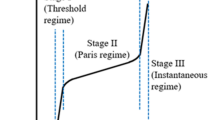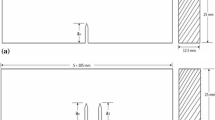Abstract
The goal of this paper is to investigate the fatigue crack growth (FCG) path in 7075-T6 aluminum alloy affected by small hole. The codes ANSYS and FRANC3D are jointly used to compute the stress intensity factors and predict the FCG path. The predicted results show that the fatigue crack turns its growth direction toward the hole. The different locations and sizes of single hole have different influences on the FCG paths, while two symmetrically distributed holes have no effects on the FCG path. The predicted FCG paths are validated by the related FCG test results.














Similar content being viewed by others
References
A.Y.T. Leung, R.K.L. Su, A numerical study of singular stress field of 3D cracks. Finite Elem. Anal. Des. 18, 389–401 (1995)
G.R. Irwin, Analysis of stresses and strains near the end of a crack traversing a plate. J. Appl. Mech. 24, 361–364 (1957)
R. Arone, M. Perl, Influence of autofrettage on the stress intensity factors for a thick-walled cylinder with radial cracks of unequal length. Int. J. Fract. 39, 29–34 (1989)
O.R. Drul, M.O. Levitskii, A model of roughness-induced crack closure. Sov. Mater. Sci. 24, 81–87 (1988)
J.R. Rice, A path independent integral and approximate analysis of strain concentrations by notches and cracks. J. Appl. Mech. 35, 379–386 (1968)
G.P. Nikishkov, S.N. Atluri, Calculation of fracture mechanics parameters for an arbitrary three-dimensional crack by the equivalent domain integral method. Int. J. Numer. Methods Eng. 24, 1801–1821 (1987)
N. Muthu, B.G. Flazon, S.K. Maiti, S. Khoddam, Modified crack closure integral technique for extraction of SIFs in meshfree methods. Finite Elem. Anal. Des. 78, 25–39 (2014)
M. Nagai, T. Ikeda, N. Miyazaki, Stress intensity factor analysis of a three-dimensional interface crack between dissimilar anisotropic materials. Eng. Fract. Mech. 74, 2481–2497 (2007)
J.M. Alegre, F. Gutiérrez-Solana, A. Aragón, A finite element simulation methodology of the fatigue behaviour of punched and drilled plate components. Eng. Fail. Anal. 11, 737–750 (2004)
J. Joel, Schubbe, Plate thickness variation effects on crack growth rates in 7050-T7451 alloy thick plate. J. Mater. Eng. Perform. 20, 147–154 (2011)
S.K. Giri, D. Bhattacharjee, Fatigue behavior of thin sheets of DP590 dual-phase steel. J. Mater. Eng. Perform. 21, 988–994 (2012)
G. Bhardwaj, I.V. Singh, B.K. Mishra, Stochastic fatigue crack growth simulation of interfacial crack in bi-layered FCMs using XIGA. Comput. Methods Appl. Mech. Eng. 284, 186–229 (2015)
B. Muñoz-Abella, L. Rubio, Rubio, P., Stress intensity factor estimation for unbalanced rotating cracked shafts by artificial neural networks. Fatigue Fract. Eng. Mater. Struct. 38, 352–367 (2015)
J. Toribio, N. Álvarez, B. González, J.C. Matos, A critical review of stress intensity factor solutions for surface cracks in round bars subjected to tension loading. Eng. Fail. Anal. 16, 794–809 (2009)
H.Q. Nguyen, L. Gallimard, C. Bathias, Numerical simulation of the coupling between thermal dissipation and fish-eye crack growth in very high cycle fatigue regime. Fatigue Fract. Eng. Mater. Struct. 36, 450–461 (2013)
A. Amiri Rad, M.R. Forouzan, A. Sadeghi Dolatabadi, Three-dimensional fatigue crack growth modelling in a helical gear using extended finite element method. Fatigue Fract. Eng. Mater. Struct. 37, 581–591 (2014)
E. Poursaeidi, H. Bakhtiari, Fatigue crack growth simulation in a first stage of compressor blade. Eng. Fail. Anal. 45, 314–325 (2014)
R. Seifi, O. Ghadimian, M. Ranjbaran, Study on life and path of fatigue cracks in multiple site damage plates. Int. J. Fatigue 80, 449–458 (2015)
X.F. Hu, W.A. Yao, A new enriched finite element for fatigue crack growth. Int. J. Fatigue 48, 247–256 (2013)
J.M. Barsom, S.T. Rolfe, Fracture and Fatigue Control in Structures: Application of Fracture Mechanics (ASTM, Philadelphia, 1999)
FAC, FRANC3D Reference Manual version 6.0, New York (2011)
R.S. Christopher, Uncertainty Quantification in Crack Growth Modeling Under Multi-Axial Variable Amplitude Loading, Doctor’s Thesis, Vanderbilt University, Nashville (2010)
NASA, Fatigue crack growth computer program NASGRO Version 3.0-Reference manual. Lyndon B. Johnson Space Center, Texas (2000)
T. Nishioka, S.N. Atluri, Analytical solution for embedded elliptical cracks, and finite element alternating method for elliptical surface cracks, subjected to arbitrary loadings. Eng. Fract. Mech. 17, 247–268 (1983)
I. Varfolomeev, M. Burdack, S. Moroz, D. Siegele, K. Kadau, Fatigue crack growth rates and paths in two planar specimens under mixed mode loading. Int. J. Fatigue 58, 12–19 (2014)
Acknowledgments
The authors are grateful for the support provided by the National Natural Science Foundation of China (No. 51175002) and the National Natural Science Foundation of Anhui province (No. 090414156).
Author information
Authors and Affiliations
Corresponding author
Rights and permissions
About this article
Cite this article
Zhang, XQ., Zhang, X., Li, L. et al. Investigation of the Influence of Small Hole on the Fatigue Crack Growth Path. J Fail. Anal. and Preven. 16, 391–399 (2016). https://doi.org/10.1007/s11668-016-0098-x
Received:
Published:
Issue Date:
DOI: https://doi.org/10.1007/s11668-016-0098-x




